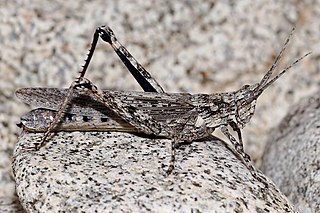Psoloessa is a genus of slant-faced grasshoppers in the family Acrididae. There are at least four described species in Psoloessa.
Horesidotes is a genus of slant-faced grasshoppers in the family Acrididae. There are at least two described species in Horesidotes.
Prorocorypha is a genus of slant-faced grasshoppers in the family Acrididae. There is one described species in Prorocorypha, P. snowi.

Opeia is a genus of slant-faced grasshoppers in the family Acrididae. There are at least two described species in Opeia.
Eupnigodes is a genus of slant-faced grasshoppers in the family Acrididae. There are at least two described species in Eupnigodes.
Cordillacris is a genus of slant-faced grasshoppers in the family Acrididae. There are at least two described species in Cordillacris.
Ageneotettix is a genus of slant-faced grasshoppers in the family Acrididae. There are at least three described species in Ageneotettix.
Bruneria is a genus of slant-faced grasshoppers in the family Acrididae. There are at least three described species in Bruneria.

Cibolacris is a genus of slant-faced grasshoppers in the family Acrididae. There are at least four described species in Cibolacris.
Bootettix is a genus of slant-faced grasshoppers in the family Acrididae. There are at least two described species in Bootettix.

Orphulella is a genus of slant-faced grasshoppers in the family Acrididae. There are more than 20 described species in Orphulella, all found in the Americas.
Heliaula is a genus of slant-faced grasshoppers in the family Acrididae. There is one described species in Heliaula, H. rufa.

Aulocara is a genus of slant-faced grasshoppers in the family Acrididae. There are at least three described species in Aulocara.
Xeracris is a genus of slant-faced grasshoppers in the family Acrididae. There are at least two described species in Xeracris.
Eritettix is a genus of slant-faced grasshoppers in the family Acrididae. There are at least four described species in Eritettix.

Mermiria is a genus of slant-faced grasshoppers in the family Acrididae. There are at least four described species in Mermiria.
Acantherus is a genus of slant-faced grasshoppers in the family Acrididae. There is one described species in Acantherus, A. piperatus.

Amblytropidia is a genus of slant-faced grasshoppers in the family Acrididae. There are about 14 described species in Amblytropidia.
Esselenia is a genus of slant-faced grasshoppers in the family Acrididae. There is one described species in Esselenia, E. vanduzeei.
Pseudopomala is a genus of slant-faced grasshoppers in the family Acrididae. There is one described species in Pseudopomala, P. brachyptera.







